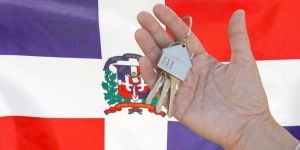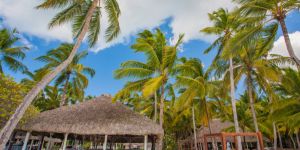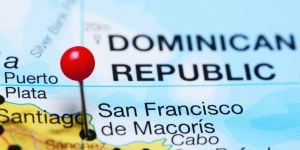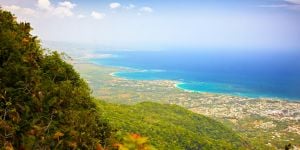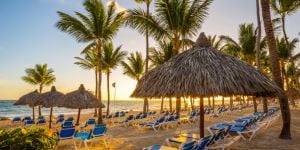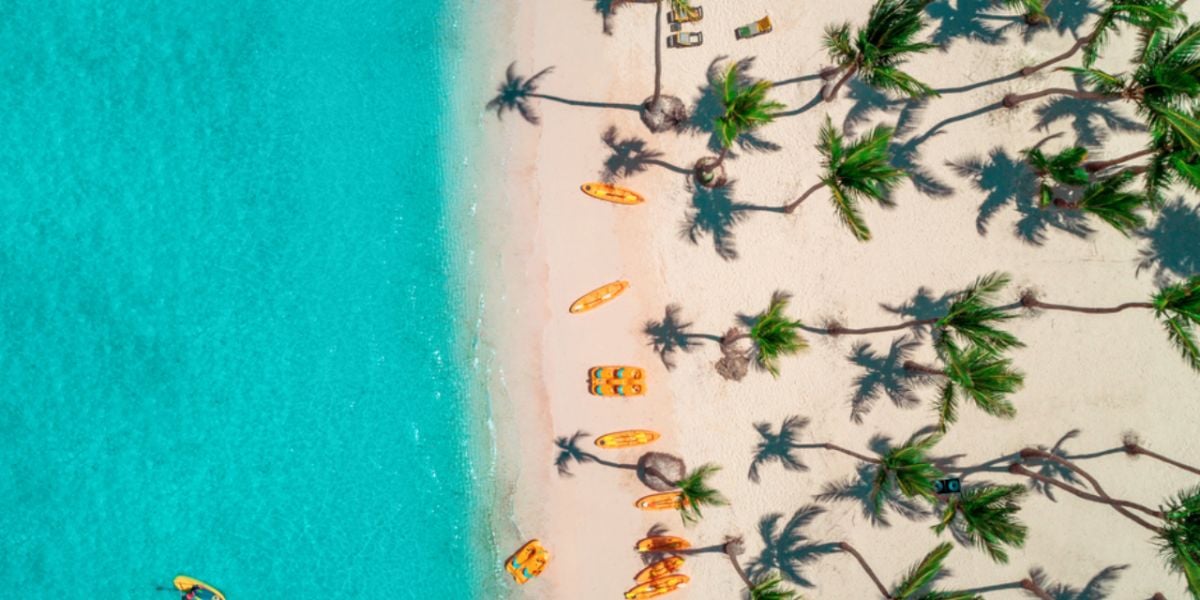
The Samaná Peninsula is situated in the very northeast of the Dominican Republic (DR). Famous for its beautiful sandy beaches and the visit of the humpback whales each year, it is the latest hotspot for expats moving to the Dominican Republic.
General information about Las Terrenas, Las Galeras, and Samaná
Samaná is a fantastic small peninsula in the northeastern part of the DR. It has mountains that run along its center, with Las Terrenas on the Atlantic Ocean to the North, boasting some of the most beautiful beaches in the entire country. On the South end of the peninsula is the city of Samana itself, which borders the bay of Samana, and right on the very eastern tip, you can find the sleepy village of Las Galeras. Samaná is the largest town, or to give it its full name, Santa Bárbara de Samaná, which is the departure point for whale-watching from mid-January to late March and also the starting point for an excursion to Los Haitises National Park across the bay.
Las Terrenas is the place where most expats settle and can enjoy an amazing European feel, with the first arrivals being the French in the early 1980s. There are superb shops, supermarkets, French bakeries, and lovely beaches, including Playa Bonita, West of Las Terrenas, and Playa Ballenas and Playa Popy to the East, which are instead quieter and ideal for relaxation. The other beach is Playa Coson, which offers breathtaking scenery.
Las Galeras is a small fishing community 28 kilometers northeast of Samaná. It is truly a jewel, drawing a combination of European and North American visitors and being a haven for independent travelers.
What about expats in Las Terrenas, Las Galeras, and Samaná?
Las Terrenas was founded relatively recently, in 1946, when then-President Rafael Leonidas Trujillo ordered the rural inhabitants of Santo Domingo to move North to the town as farmers and fishers, which was then a small fishing village totally isolated from the rest of the country due to the lack of roads. Even as recently as 1975, Las Terrenas was a small village of farmers and fishermen with no stores, no gasoline station, no electricity, no telephones, no cars, no motorcycles, no post office, no newspapers, and no tourists.
Now it has a population of over 22,664 with over 6,000 expats from over 20 different countries, most being from France, Italy, the United Kingdom, and Germany, but with a reversal in buying trends recently with the North Americans and Canadians moving in and totaling over 30% of current property sales. Las Terrenas is now the most sought-after location for expats in the Dominican Republic.
Samaná has an intriguing expat history; in the 1820s, thousands of escaping American slaves relocated to Samaná, keeping their American customs and speaking English. Samaná, in the mid-1950s, was an English-speaking Protestant outpost of a Spanish-speaking Catholic country until the dictator Rafael Trujillo introduced the Spanish language into Samaná and forced the people to speak it. Even today, however, most people in Samaná are bilingual, and it is home to many expats.
Las Galeras also has several expats who own guesthouses and run excursions, but it is significantly quieter than the other parts of the peninsula.
Accommodation types in Las Terrenas, Las Galeras, and Samaná
There is a wide range of accommodation available on the peninsula, probably more than anywhere else on the island. There is literally something for everyone, from small to large, old to ultra-modern condos to gated communities, and prices are very reasonable, even for beach-front properties. Many expats also live in the hills, with spectacular sea views.
Suppose you are looking to stay longer or to move to the DR. In that case, it is best to either get in touch with a local rental agency, check the available long-term rentals on Mercado Libre (the Latin-American version of Amazon), or join some rental groups on Facebook – these are usually the best way to rent from locals and avoid high commission fees directly. A regular one-bedroom apartment will cost you around 500 USD per month, but you can always find cheaper offers, especially if you're looking for studios, or you could share with a friend/roommate.
Of course, there is always the option to rent something on Airbnb, at least to get started and take it from there. Depending on the month and, therefore, season, sometimes you can find some real gems, like three-bedroom villas for around 1000 USD per month and even better!
Cost of living in Las Terrenas, Las Galeras, and Samaná
An average weekly trip to the grocery store will cost around US$100, and fresh fruits and fresh fish – which are always available – can be bought separately. There are two excellent supermarkets in Las Terrenas: one is the Dominican chain Super Pola, and the other is a French supermarket with a superb selection of wine.
Electricity used to be run by a private company but has now joined the national grid and, like the rest of the country, is subject to frequent outages. The average electricity bill for a two-bedroom apartment without air conditioning is around US$50 a month, and cooking gas and hot water is around US$40 a month. Internet access that has more than 100 Mbps will be another 50 USD extra.
A vacation rental can be pretty pricey in this part of the Dominican Republic, with weekly rents from around 1400 USD to more than 5000 USD or even higher if you're looking for luxurious villas. They tend to offer modern Westernized standards and come with beautiful furnishing, and many are located right near the beach.
Fans of sports and more so gyms should include more or less 30 USD in their calculation of costs for a monthly membership in a gym.
If you have children or are planning on extending your family while living in the Dominican Republic, you should be aware of costs for schools, etc.
The monthly fee for a private preschool or kindergarten is around 200 USD, while the annual payment for an international primary school for one child is roughly between 4000 USD and 5000 USD.
Going to the cinema is relatively cheap, with prices per ticket being around 5 USD. Restaurant visits could become a bit expensive over time if you want to enjoy some international standards. A three-course meal in a middle-class restaurant for two people will probably cost around 35 USD to 40 USD – this can obviously be higher, depending on the restaurant. Beer tends to be quite expensive compared to the prices in neighboring countries, like Mexico, etc.
If you buy it in a restaurant, a local beer usually costs 2,55 USD (500 mL), and an imported one at least 4,50 USD. Going to the supermarket to get some beer to enjoy at home will be slightly cheaper. Nationally-brewed beer costs around 2 USD, and imported brands cost 3 USD and up.
The region of Samaná is, of course, a bit more expensive than many other parts, being a tourist hot spot with a slightly more luxurious focus.
Leisure activities in Las Terrenas, Las Galeras, and Samaná
There is a plethora of leisure activities throughout the Samaná peninsula, ranging from golfing to water sports, especially scuba diving and hiking.
The El Limon Waterfalls are a must and involve hiking on foot or on a horse or even going to the waterfalls by canoe. It takes around three hours.
The Los Haitises National Park is another not-to-be-missed excursion. It is a natural wonderland with exotic birds and abundant vegetation and is home to several Taino Indian caves and archaeological sites.
One of the most famous activities in the whole country is watching the humpback whales in Samaná Bay when they arrive to give birth and mate from the end of January to the end of March.
There is also zip lining on the peninsula, deep-sea fishing opportunities, and many quiet and undisturbed beaches. It is a beach and nature lover's paradise. We've gathered the most beautiful beaches in the following list to give you some examples.
The top four beaches of Samana
Playa Coson
You can reach this beach easily while on the road to Las Terrenas, and it is one of the first ones you will come across. The best part is that in case you don't have time to go for a swim, you can admire its beauty from the viewpoint of Boulevard de Atlántico. Playa Cosón is a tremendously wide beach that seems to be neverending. It is one of those beaches that look like the Bacardi advertisement, full of palm trees and super idyllic, as there are hardly any hotels. Usually, you will have this beach primarily to yourself because there is no infrastructure, and besides the two hotels and a few luxurious private villas, there are no buildings.
Playa Morón
If you are looking for a beach with excellent service and a more resort-like atmosphere, Playa Morón is your perfect choice. You'll get there from Las Terrenas towards El Limón, a small town where you can also find the beautiful waterfall named Salto el Limón.
Playa Lanza del Norte
This beach is one of the country's hidden gems, as it is not as easy to find as other beaches. Once you are on the road to Playa Morón, as mentioned above, don't take a left turn but stay on this road. It might get a bit bumpy, though, so a 4WD car is probably not the wrong choice. Once you've reached its end, you will literally find paradise – a pristine place with crystal-clear water and an untouched landscape. The only downside is that the beach is not suitable for swimming due to its strong currents and high waves, but you can definitely take breathtaking pictures and dip your toes into the water.
Playa Onda Samaná
Even more secluded and only reached through a hiking trail, you will find this little oasis named Playa Onda. It is one of the smaller beaches, nevertheless, one that takes your breath away. Swimming is not advised because the water can get pretty rough here. Most of the time, you'll be alone on the beach because there are not many tourists who make an effort to hike to a beach when there are plenty of easily accessible ones across the country. As it is open terrain, doing the hike with an experienced guide is recommended.
Restaurants in Las Terrenas, Las Galeras, and Samaná
One is totally spoiled for choice when it comes to eating out in the Samaná peninsula. There is a wide range of options, including Dominican, French, German, Mexican, and many others. You can choose your own fish and lobster and eat on the beach or treat yourself to a high-end French restaurant.
Given that the peninsula is surrounded by the ocean, fish and seafood are plentiful, as are fresh fruit and vegetables, especially coconuts. In fact, fish in coconut sauce is a native dish to Samaná.
Restaurant prices are a little higher in Las Terrenas than in the rest of the country, especially in what is known as Fisherman's Village, a row of brightly colored wooden bars and restaurants just at the end of the main street and facing the beach.
However, several “secret” places cater to expats and local residents, and their prices are much more reasonable.
Transport in Las Terrenas, Las Galeras, and Samaná
There is an international airport in Samaná called El Catey International Airport, and it offers flights from Europe and Canada.
There is also a cruise terminal in Samaná, which attracts cruise ships during the winter Caribbean cruising season.
A new highway was opened a few years ago linking the Samaná peninsula with Santo Domingo, which has cut the journey down from several hours to now only two hours, and the new Atlantic Boulevard, as it is known, means that there is no need to cross the mountain from the South to the North of the peninsula either.
There are long-distance coaches and buses to Santo Domingo, Santiago, and Puerto Plata. Around town, there are motorcycle taxis and regular taxis as well as guaguas to other towns in the peninsula. Las Terrenas is also home to several four-wheeled ATVs, which are often rented by visitors and locals to get around town.
Useful links:
We do our best to provide accurate and up to date information. However, if you have noticed any inaccuracies in this article, please let us know in the comments section below.
